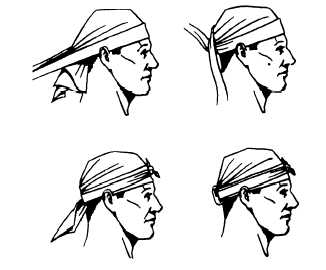is secured with a pin or strip of adhesive tape at the crossing on top of the head. It may be used for fractures of the lower jaw and to retain compresses to the chin (fig. 4-31).

Figure 4-31.—Barton bandage.

Figure 4-32.—Triangular bandage.
Triangular Bandage
Triangular bandages are usually made of muslin. They are made by cutting a 36” to 40” square of a piece of cloth and then cutting the square diagonally, thus making two triangular bandages (in sterile packs on the Navy’s medical stock list). A smaller bandage may be made by folding a large handkerchief diagonally. The longest side of the triangular bandage is called the base; the corner directly opposite the middle of the base is called the point; and the other two corners are called ends (fig. 4-32).
The triangular bandage is useful because it can be folded in a variety of ways to fit almost any part of the body. Padding may be added to areas that may become uncomfortable.

Figure 4-33.—Triangular bandage for the head.
TRIANGULAR BANDAGE FOR HEAD.– This bandage is used to retain compresses on the forehead or scalp. Fold back the base about 2 inches to make a hem. Place the middle of the base on the forehead, just above the eyebrows, with the hem on the outside. Let the point fall over the head and down over the occiput (back of the head). Bring the ends of the triangle around the back of the head above the ears, cross them over the point, carry them around the forehead and tie in a SQUARE KNOT. Hold the compress firmly with one hand and, with the other, gently pull down the point until the compress is snug; then bring the point up and tuck it over and in the bandage where it crosses the back part of the head (fig. 4-33).
TRIANGULAR BANDAGE FOR SHOULDER.– Cut or tear the point, perpendicular to the base, about 10 inches. Tie the two points loosely around the patient’s neck, allowing the base to drape down over the compress on the injured side. Fold the base to the desired width, grasp the ends, and fold or roll the sides toward the shoulder to store the excess bandage. Wrap the ends snugly around the upper arm, and tie on the outside surface of the arm (fig. 4-34).
TRIANGULAR BANDAGE FOR CHEST.– Cut or tear the point, perpendicular to the base about 10 inches. Tie the two points loosely around the patient’s neck, allowing the bandage to drape
